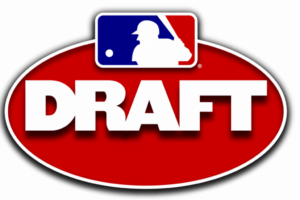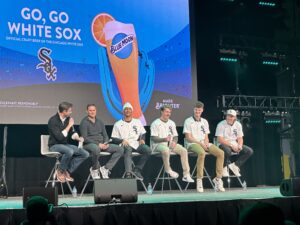White Sox get Samardzija, Ynoa for Four Prospects
The White Sox have acquired pitchers Jeff Samardzija and Michael Ynoa from the Oakland Athletics, in exchange for four prospects: INF Marcus Semien, RHP Chris Bassitt, 1B Rangel Ravelo and C Josh Phegley.
Of course, most of you already know that. And Samardzija is a known commodity – a very effective right-handed starter who immediately makes the front three of the White Sox rotation quite formidable. He also has only one year left on his current contract, so the Sox will have a puzzle to solve if they want him to stick around. But that is for another article.
We’re going to focus on the prospects involved in the trade, as is our wont. Who is this Michael Ynoa guy the South Siders got? And what did they really lose in those four prospects?
Added: Michael Ynoa
Ynoa was at one time one of the most highly considered prospects signed out of the Dominican Republic. The A’s signed this 6’7″ right-hander for $4.25M (a club record bonus at that time) in 2008, and early scouting reports talked of a power fastball and flashes of good breaking stuff from a tall frame on a 16-17 year old kid. He was ranked the #54 prospect in all of baseball by Baseball America in 2009, despite not yet seeing pro action.
But in 2010, after just a first few pro games, Ynoa (sometimes called Inoa) was sidelined and had Tommy John surgery. Through 2012, due to injuries and recovery time, he’d only been able to throw about 40 innings in games, some 4 years after he’d signed. 2013 was the first encouraging set of signs on the field, as he logged 75.2 innings across two levels of A-ball in his age 21 seasons, posting decent if unspectacular numbers. He was still the #5 prospect in the Oakland organization that year, again per BA.
That takes us to 2014. In terms of performance, working exclusively in relief, Ynoa posted 64 strikeouts in 45.2 innings, though his core numbers weren’t great. He’s still got a fastball that has been rated among the best in the A’s system, and his curveball has been special at times. But recent reports aren’t as rosy. Here is a video from Shadows of Wrigley.
The good news is, he’s still just 23 years old, and a perfect patient for Dr. Cooper’s Fix ‘Em clinic. The fastball is still a dancing mid-90’s beast, and he’s got some significant ceiling. But he won’t be a major league contributor soon, if ever.
Traded away: Marcus Semien
Sox fans may only know Semien from his limited stints in Chicago. Combined across 2013 and 2014, the Cal product posted a .243/.290/.380 line in 82 games, striking out 28.2% of the time and struggling defensively while learning the hot corner. His defense at his more native second base was better, and he saw some very limited play at shortstop. While he did show a knack for “clutch” hits, the overall results weren’t anything to write home about.
Those results don’t paint the full picture, though. In terms of skills, this infielder had among the best plate discipline in the system, played a solid second base with the ability to play elsewhere when needed, and was very efficient on the basepaths. The raw tools included above average speed, an arm strong enough to play across the diamond, game power that plays above average for a middle infielder, and decent hands with the glove. His range isn’t great, and he’s not looked like a big power guy going forward, but there is plenty to like. The lack of any truly plus tool meant he wasn’t showing up on top prospect lists across baseball, and was perhaps a bit under the radar.
The results of that package bloomed starting in 2012 and exploded in 2013, when he posted a .284/.401/.479 line with 15 HR and 20 SB in just 105 games across AA and AAA (and earning him Southern League MVP honors). His 2014 in Charlotte was also strong (.267/.380/.502, 15 HR, 7 SB in just 366 PA). The most impressive statistical feats, beyond the power and speed numbers, was that he walked (151) more than he struck out (149) in those two years.
What will his MLB future look like? Oakland seems focused on him playing shortstop, where he should provide solid hands and a playable arm, but he’s not going to be an elite or even above average defender (mostly due to lack of range). Offensively he’s shown he will likely have very good plate discipline and a little power, so a .260/.350/.390 line is probably a reasonable expectation if things go well. For more background, here is our interview with him from 2013.
Traded away: Chris Bassitt
The pedigree isn’t splashy: 16th round pick in 2011 as a reliever from Akron. He didn’t get much attention as an effective but unknown reliever during his first 1.5 pro seasons, though there were reports even then of a good fastball that could reach mid 90’s. The Sox transitioned him to a starting role midway through 2012, which the club often does with relievers to get more refinement. Then in 2013 he broke out, in 26 starts across A+ and AA: 3.08 ERA (2.27 in AA), 138 K vs 59 BB in 149 IP. He was nails in Birmingham’s Southern League Championship run, and adding in an AFL appearance, his total game innings that year were nearly double the year prior.
As Bassitt matured through 2013 and 2014, the scouting reports started filling in. His fastball draws consistently positive reviews as being above average or even plus, running 92-96 with some late run. The slider hasn’t been as consistent, but shows above average more and more often. The change-up is a work-in-progress, has flashed solid at best, and is probably the difference-maker. If that can become at least a league-average pitch, he may be able to stick as a back-end starter. He does have some deception in his delivery as well.
More likely, Bassitt profiles as a successful middle or late-inning reliever in MLB, focusing mostly on the FB-SL combo. In fact, when we interviewed Chris in 2013, he stated he prefers working from the bullpen. He’s stated similar things since as well. You can check out some video links in his profile here.
Traded away: Rangel Ravelo
Ravelo is a guy whose future projections from scouting types ranges from starting 1B down to AAA filler. The difference-maker for him seems mostly about power projection.
There’s no doubt Ravelo can hit – his career line in the minors is .301/.368/.424, and that is while playing young-for-level at basically every stop. He also has very good plate discipline, as evidenced by a K:BB ratio of 134:107 the past two seasons across three levels. But despite projections from draft time of future power, until 2014, the most HR he hit in a season was four. He did jump to 11 in 2014, and reports from scouts indicate he can put on a show in BP. There is a video of him hitting an absolute bomb in a game in Winston-Salem within this scouting report from Nathaniel Stoltz of Fangraphs.
A few interesting notes. Ravelo was a 3B when he first entered the system, but the Sox moved him to 1B in 2013 and there is no indication he can move back (though some have suggested it should be tried). If he could play there, he’d be there. Also, he missed more than half the 2012 season when he left the team to attend to personal matters, so he is effectively even more ahead of the age development curve than you may think.
What it comes down to is – will Ravelo develop enough power to be league-average in that area compared to other 1B’s? He hits a ton of doubles, and the home runs did jump last year. If he can develop 15-20 HR power, with his other offensive tools (he’s got them all except speed), he could be an MLB 1B. The jury is still out.
Traded away: Josh Phegley
One could write a book on all the drama in this Indiana product’s short career thus far. Drafted 38th overall in 2009 as a bat-first catcher, he skipped rookie ball and posted middling results in Kannapolis. Then he was struck by a rare medical condition (ITP) which essentially wiped out his 2010 and some of 2011. The team kept promoting him anyway, he missed more time due to a wrist injury, and the next thing you know he’s in AAA in late 2011 with just 190 minor league games under his belt. Not surprisingly, his first full year of AAA in 2012 was unspectacular (.266/.306/.373, 6 HR, just 20 walks in 102 games).
Then in 2013, having finally had a chance to adjust, he busted out offensively: .316/.368/.597, 15 HR in just 258 PA. Promoted to Chicago to split time with the struggling Tyler Flowers, he hit two homers in his first three games giving Sox fans a case of Phegley Phever. Unfortunately this illness had some nasty side effects, and he went on to finish with a .522 OPS and a nearly complete refusal to take a walk. 2014 opened with more drama, as Phegley was booted from major league camp in Spring Training much earlier than anticipated, accompanied by the org making unusually critical public statements about his lack of preparation with pitchers. That put Josh in Charlotte again, where he hit well again, though he was benched at one point for reasons that seem related to his earlier issues. Then he disappointed in Chicago again (.216 AVG, .211 OBP, lots of whiffs and defensive blunders).
Phegley has plenty of power, and at times has shown a very strong hit tool. Defensively, he has a strong arm, but also a concrete glove and an apparent issue working well with others. Both of those could improve with time, but today, he’s not shown he is a playable MLB catcher on the defensive side of the ball.
CONCLUSION
Josh Phegley didn’t have a future role with the club, and Rangel Ravelo was blocked in Chicago at the 1B and DH slots – so the loss is minimal here and both players have a better shot elsewhere. Bassitt has a decent chance to be an effective middle reliever, which the Sox could use, so there is some loss there. Semien is at least a solid utility infielder, and very well could be a starting 2B in the majors – but the Sox have Carlos Sanchez and Micah Johnson respectively to fill those roles. Basically, the Sox gave up three guys they have internal replacements for, and one guy (Bassitt) who they may not.
In return they got one of the better right-handed starters in baseball, and a pitching prospect with a lot of talent who may still blossom. It is hard not to call this trade a win for the White Sox. But it also looks like a potential win for the Athletics, who can make use of Bassitt, Semien and Ravelo in ways Chicago likely would not have been able to.
Want to know right away when we publish a new article? Type your email address in the box and click the “create subscription” button. Our list is completely spam free, and you can opt out at any time.






